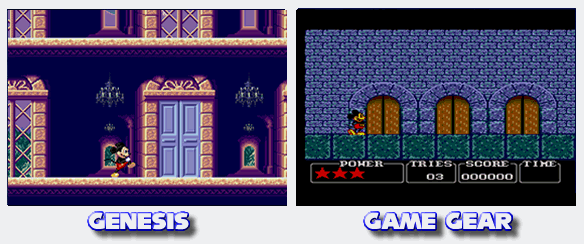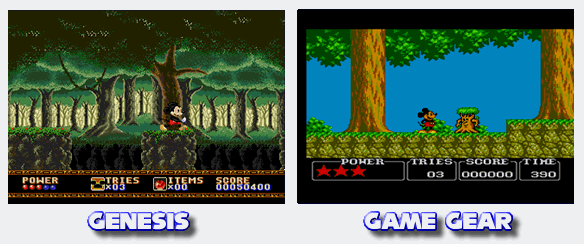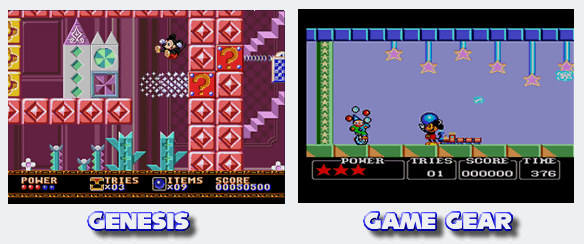Just about everyone has played Castle of Illusion on Genesis. But when you see that Game Gear title in a list, or on a store shelf, you’re probably thinking “ahh, it’s probably just a crummy 8-bit port of the same game I have for Genesis.” Au contraire my friend! Looks are deceiving. Although Castle of Illusion may look the same on the outside, what’s on the inside is MUCH different in many ways. Come into each castle with me my friend, and take a look inside for yourself.
You start off the game with more or less the same intro and storyline in both games. Mickey and Minnie living happily in Vera City , Mizrabel comes down and swipes Minnie, Mickey runs to the Castle of Illusion. You choose your difficulty (hard is absent from the Game Gear version); see the old man in the castle who tells you to get the gems. You run in, and aside from the music, which is probably the only thing both games share completely, including what levels they appear in and a few enemies, is where the similarities STOP between the two games. But what’s different between the two? read on!
The Differences
Presentation: The levels also vary in design greatly between the two games. This is one of the key differences between the two that people don’t tend to notice. The first three levels in Castle of Illusion on the Genesis are the forest, the toys, and the canyons/caves. They go in a linear fashion from left to right, or up to down. The first three levels on the Game Gear, however, are designed differently. The first three levels are the forest, the toys, and SWEETS. Also, the levels go in all directions rather than just one. They go up, down, left, and right. There are different paths to choose from, and there’s not really one set linear path. Also, the third level in Game Gear starts off as an automatic scrolling level as seen in Super Mario Bros. 3, something that isn’t seen AT ALL in the Genesis version. Also, where the levels are split up into parts on the Genesis, the Game Gear version just has one big level, and then a boss. There are no exit doors or entering from one locale to another inside levels in the Game Gear version. Also, the practice modes differ from Genesis and Game Gear games. The Genesis one cuts back on levels entirely, whereas the Game Gear cuts out parts of levels instead. I’m going to have to give this one to the Game Gear here, for giving practice players a sample of all the levels and a choice of which one to go to first.
Edge: Game Gear
Graphics: The graphics in each game don’t exactly differ that much, they both create the scene equally. Of course Genesis is going to have the better graphics and sound, but it’s a not a really big difference. They’ve both got that nice Mickey Mouse cartoony feel to each game, Although the backgrounds in Castle of Illusion for Game Gear are pretty much block colors at times.
Edge: Genesis
Sound/Music: The songs don’t really become that unrecognizable between the two games. The music and sound effects are entirely shared between the two games. No levels have different music from each other (except for the level where you are swimming in the tea cup), and even the intro has the same theme. Although the music where you’re in the castle before eachg level seems to have been omitted from the Game Gear rendition. But of course, the Genesis is going to sound better and look better.
Enchanted Forest: Genesis (MP3 2.04 megs) Enchanted Forest: Master System (MP3 1.13 megs)
Edge: Genesis
Gameplay: The gameplay is another place where the two games differ greatly. At first glance, the two games play identically. Mickey runs and jumps on enemies and goes through levels. But look closely and you will notice that they play very differently. Genesis Castle of Illusion is a run and jump that lets you collect items that you can throw at enemies. On the Game Gear, however, it has a different system. It maintains the run and jump techniques of the Genesis version, but instead of having throwing items, it instead includes treasure chests that contain goodies (where as in the Genesis games items just floated in mid-air) and rocks or other things, such as barrels that are laying around that you can pick up, throw, and stack. The rocks allow you to get to other places, or to kill certain enemies, or to trigger switches, whereas the items in the Genesis game are only used on enemies. The game gear game brings a puzzle element to the table. There’s a lot of variety and difference between the gameplay of the two games. Also, the Game Gear version of Castle of Illusion has added coins as an item simply to gain points.
Also, in the Genesis version you get two continues, whereas the Game Gear version gives you none at all at the start. You have to earn them yourself. You can earn nine continues in the Game Gear version after you beat the first level off the bat, but can’t get anymore after that. Yyou only get two in the Genesis version. That’s one area where the Game Gear wins out. But in contrast, the Genesis version allows you to gain health up to five hits, where the Game Gear game only gives you up to three (until very late in the game, where you can collect a star to be able to take four hits) One more thing that is different is that the Game Gear version of Castle of Illusion is considerably harder than the Genesis one, especially the bosses, and adds a timer to each level in which you have to complete the level in a certain amount of time (about 380 seconds) similar to Super Mario Bros. But each game has their advantages and disadvantages, so I’m going to have to tie this one.
Edge: Draw
Other: Each game is your standard platform stuff, and once you beat either one, there’s not much reason to go back to them unless you really like them. You’ll most likely be spending more time on the Game Gear version though due to it’s higher difficulty.
Edge: Draw
Final Assessment
Castle of Illusion for Genesis and for Game Gear are two very different games. If you haven’t played one but have played the other, I do recommend that you do play both, they’re both unique in their own way, and complimentary to each other. Both have major differences from each other. So remember kids, when you see a port of a game, don’t knock it off quite yet.




Recent Comments